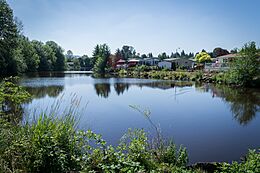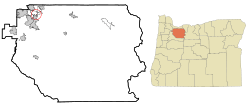Johnson City, Oregon facts for kids
Quick facts for kids
Johnson City, Oregon
|
|
|---|---|

Lake Leona in Johnson City, Oregon
|
|

Location in Oregon
|
|
| Country | United States |
| State | Oregon |
| County | Clackamas |
| Incorporated | 1970 |
| Area | |
| • Total | 0.07 sq mi (0.18 km2) |
| • Land | 0.07 sq mi (0.17 km2) |
| • Water | 0.00 sq mi (0.01 km2) |
| Elevation | 112 ft (34 m) |
| Population
(2020)
|
|
| • Total | 539 |
| • Density | 8,292.31/sq mi (3,204.59/km2) |
| Time zone | UTC-8 (Pacific) |
| • Summer (DST) | UTC-7 (Pacific) |
| ZIP code |
97267
|
| Area code(s) | 503 and 971 |
| FIPS code | 41-37650 |
| GNIS feature ID | 2410145 |
Johnson City is a small city in Clackamas County, Oregon, United States. In 2010, 566 people lived there. It is known for being the most densely populated city in Oregon. This means many people live in a very small area.
Contents
History of Johnson City
On June 16, 1970, the people living in a trailer park decided to make their community a city. This trailer park was owned by Delbert Johnson. The residents voted 49 to 10 to become an official city.
Delbert Johnson started this community in 1959. In 1968, he tried to have the area join Gladstone, a nearby city. But this attempt was not successful.
In 1969, a new law was made to stop too many small cities from forming. However, the people wanting Johnson City to become a city had already started the process before this law began. This is why Johnson City was able to become a city. The community is also known as Johnson Mobile Estates.
Community Services
People living in Johnson City cannot use some services that other people in Clackamas County can. For example, they cannot use the county library system, called LINCC. They also cannot join programs from North Clackamas Parks and Recreation (NCPRD). This includes services like Meals on Wheels.
In 2022, a group called the Johnson City Tenant Collective tried to help residents join the LINCC library system. They put a measure on the election ballot, Measure 3-585. However, this measure did not pass.
Geography of Johnson City
Johnson City is a very small place. According to the United States Census Bureau, the city covers about 0.07 square miles (0.18 square kilometers). All of this area is land.
Population and People
| Historical population | |||
|---|---|---|---|
| Census | Pop. | %± | |
| 1980 | 378 | — | |
| 1990 | 586 | 55.0% | |
| 2000 | 634 | 8.2% | |
| 2010 | 566 | −10.7% | |
| 2020 | 539 | −4.8% | |
| U.S. Decennial Census | |||
2010 Population Information
In 2010, there were 566 people living in Johnson City. These people lived in 268 homes. About 141 of these homes were families. The city had a population density of about 8,086 people per square mile. This means many people live close together.
Most of the people in Johnson City were White (84.3%). There were also smaller numbers of African American, Native American, and Asian residents. About 15.4% of the population was Hispanic or Latino.
About 19.8% of homes had children under 18 living there. Many homes (47.4%) were not families. About 40.3% of homes had only one person living there. Also, 14.9% of homes had someone 65 years or older living alone.
The average age of people in the city was 47.1 years old. About 18.7% of residents were under 18. And 18.6% were 65 years or older. The population was almost equally split between males (48.8%) and females (51.2%).
See also
 In Spanish: Johnson City (Oregón) para niños
In Spanish: Johnson City (Oregón) para niños

